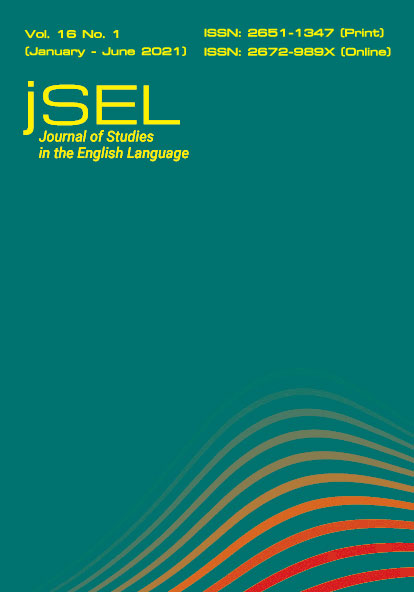A Cognitive Stylistic Approach to Mind Style in the Memoir Man’s Search for Meaning
Main Article Content
Abstract
The present study aims to examine the mind style, a distinctive perspective held by a character in a narrative, of a real-person narrator in the memoir Man’s Search for Meaning, Dr. Viktor E. Frankl, by applying the Text World and Schema theories. To investigate how his mind style is constructed textually and potentially enacted within the mind of the reader, four excerpts from the book were selected and analyzed. Through the Text World theory, the study captures a range of linguistic features into text-building elements and relates them, via the Schema theory, to the different ways in which they can interact with readers’ background knowledge to arrive at an interpretation of the extraordinary mind style of the narrator. The in-depth cognitive stylistic analysis reveals semantic contrast in the narrator’s outer and inner worlds, illustrating how he was able to attain inner riches and freedom amidst great difficulties in life in the Auschwitz concentration camp. The study not only sheds light on the linguistic portrayal of Dr. Frankl’s mind style but also contributes to the potential of cognitive stylistic approaches to mind style.
Article Details
References
Biographics. (2017, December 14). Viktor Frankl biography: A life in search of meaning. https://biographics.org/viktor-frankl-biography-life-search-meaning/
Cook, G. (1994). Discourse and literature. Oxford University Press.
Eysenk, M. W., & Keane, M. T. (2010). Cognitive psychology: A student’s handbook (6th ed.). Psychology Press.
Fiske, S. T., & Neuberg, S. L. (1990). A continuum of impression formation, from category-based to individuating processes: Influences of information and motivation on attention and interpretation. In M. P. Zanna (Ed.), Advances in experimental social psychology (pp. 1-74). Academic Press.
Fowler, R. (1977). Linguistics and the novel. Methuen.
Fowler, R. (1996). Linguistic criticism (2nd ed.). Oxford University Press.
Frankl, V. E. (2006). Man’s Search for Meaning. Beacon Press.
Gavins, J. (2007). Text world theory: An introduction. Edinburgh University Press.
Giovanelli, M. (2010). Pedagogical stylistics: A text world theory approach to the teaching of Poetry. English in Education, 44(3), 214-231. DOI: 10.1111/j.1754-8845.2010.01074.x
Giovanelli, M. (2018). Something happened, something bad: Blackouts, uncertainties and event construal in The Girl on the Train. Language and Literature, 27(1), 38-51. doi.org/10.1177/0963947017752807
Halliday, M. A. K. (1985). An introduction to functional grammar. Edward Arnold.
Harrison, C. (2017). Finding Elizabeth: Construing memory in Elizabeth is Missing by Emma Healey. Journal of Literary Semantics, 46(2), 131-151. doi.org/10.1515/jls-2017-0008
Ibrahim, W. (2014) A possible-worlds approach to Harry Potter. Thoughts, 42-65.
Jeffries, L., & McIntyre, D. (2010). Stylistics. Cambridge University Press.
Montoro, R. (2011). Multimodal realisations of mind style in Enduring Love. In R. Piazza, M. Bednarek, & F. Rossi (Eds.), Telecinematic discourse: Approaches to the language of films and television series (pp. 69-83). John Benjamins. https://doi.org/10.1075/pbns.211.06mon
Nuttall, L. (2018). Mind style and cognitive grammar: Language and worldview in speculative fiction. Bloomsbury Academic.
Palmer, A. (2004). Fictional minds. University of Nebraska Press.
Rumelhart, D. E., & Ortony, A. (1977). The representation of knowledge in memory. In R. C. Anderson, R. J. Spiro, & W. E. Montague (Eds.), Schooling and the acquisition of knowledge (pp. 99-135). Lawrence Erlbaum.
Semino, E. (1997). Language and World Creation in Poems and Other Texts. Longman.
Semino, E. (2002) A cognitive stylistic approach to mind style in narrative fiction. In E. Semino, E. & J. Culpeper (Eds.), Cognitive Stylistics: Language and cognition in text analysis (pp. 95-122). John Benjamins.
Semino, E. (2007). Mind style twenty-five years on. Style, 41(2), 153-203.
Semino, E. (2014). Language and world creation in poems and other texts. Routledge. http://site.ebrary.com/id/10944869
Stockwell, P. (2009) Texture: A cognitive aesthetics of reading. Edinburgh University Press.
Stockwell, P. (2015). Cognitive stylistics. In R. H. Jones (Ed.), The Routledge handbook of language and creativity (pp. 218-230). Routledge.
van Dijk, T. A., & Kintsch, W. (1983). Strategies of discourse comprehension. Academic Press.
Werth, P. (1994). Extended metaphor: A text world account. Language and Literature, 3(2), 79-103.
Werth, P. (1995). How to build a world (in a lot less than six days and using only what’s in your head. In L. Green (Ed.), New essays on deixis: Discourse, narrative, literature (pp. 49-80). Rodopi.
Werth, P. (1997). Remote worlds: the conceptual representation of linguistic world. In J. Nutys & E. Pederson (Eds.), Language and conceptualization (pp. 84-115). Cambridge University Press.
Werth, P. (1999). Text worlds: Representing conceptual space in discourse. Longman.


